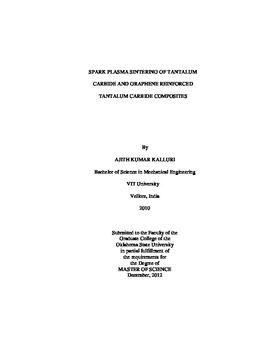| dc.contributor.advisor | Harimkar, Sandip P. | |
| dc.contributor.author | Kalluri, Ajith Kumar | |
| dc.date.accessioned | 2014-04-17T20:12:39Z | |
| dc.date.available | 2014-04-17T20:12:39Z | |
| dc.date.issued | 2012-12-01 | |
| dc.identifier.uri | https://hdl.handle.net/11244/10317 | |
| dc.description.abstract | Tantalum carbide (TaC), an ultra-high temperature ceramic (UHTC), is well known for its exceptional properties such as high hardness (15-19 GPa), melting point (3950 C), elastic modulus (537 GPa), chemical resistance, and thermal shock resistance. To make TaC to be the future material for hypersonic vehicles, it is required to improve its thermal conductivity, strength, and fracture toughness. Researchers have previously reinforced TaC ceramic with carbides of silicon and boron as well as carbon nanotubes (CNTs), however, these reinforcements either undergo chemical changes or induce defects in the matrix during processing. In addition, these reinforcements exhibit a very minimal improvement in the properties. In the present work, we attempted to improve TaC fracture toughness by reinforcing with graphene nano-platelets (GNPs) and processing through spark plasma sintering at high temperature of 2000 C, pressure of 70 MPa, and soaking time of 10 min. In addition, we investigated the active densification mechanism during SPS of TaC powder and the effect of ball milling time on mechanical properties of sintered TaC. A relative density of >96% was achieved using SPS of monolithic TaC (<3 μm). Ball milling improved the sintering kinetics and improved the mechanical properties (microhardness, bi-axial flexural strength, and indentation fracture toughness). Activation energy (100 kJ/mol) and stress exponent (1.2) were obtained using the analytical model developed for power-law creep. Grain boundary sliding is proposed as active densification mechanism based on these calculations. Reinforcing GNPs (2-6 vol.% ) in the TaC matrix improved relative density (99.8% for TaC-6 vol.% GNP). Also ~150% and ~180% increase in flexural strength and fracture toughness, respectively, was observed for TaC-6 vol.% GNP composite. The significant improvement in these properties is attributed to improved densification and toughening mechanisms such as sheet pull-out and crack deflection due to reinforcement of graphene. Uniform dispersion of GNPs in the TaC matrix is observed from microstructural analysis. Raman spectroscopy analysis also indicated that GNPs are successfully retained in sintered TaC-GNP composites without any damage. | |
| dc.format | application/pdf | |
| dc.language | en_US | |
| dc.publisher | Oklahoma State University | |
| dc.rights | Copyright is held by the author who has granted the Oklahoma State University Library the non-exclusive right to share this material in its institutional repository. Contact Digital Library Services at lib-dls@okstate.edu or 405-744-9161 for the permission policy on the use, reproduction or distribution of this material. | |
| dc.title | Spark Plasma Sintering of Tantalum Carbide and Graphene Reinforced Tantalum Carbide Composites | |
| dc.type | text | |
| dc.contributor.committeeMember | Kalkan, A. Kaan | |
| dc.contributor.committeeMember | Singh, Raman P. | |
| osu.filename | KALLURI_okstate_0664M_12554.pdf | |
| osu.college | Engineering, Architecture, and Technology | |
| osu.accesstype | Open Access | |
| dc.description.department | School of Materials Science & Engineering | |
| dc.type.genre | Thesis | |
